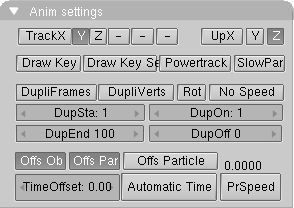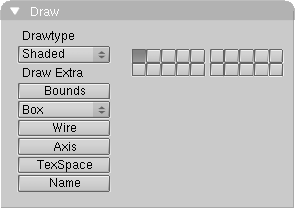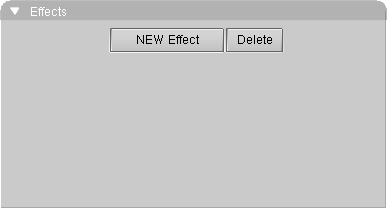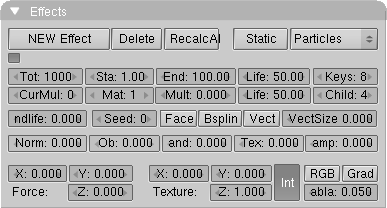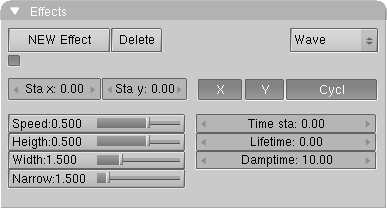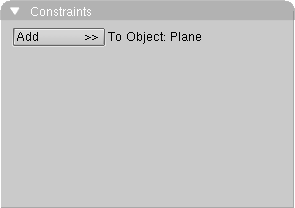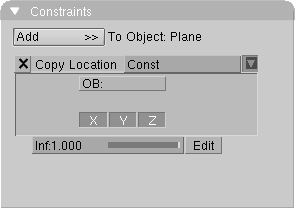Object Context
The Object Context shows the main Object Mode tools and is not divided into Sub-Contexts. It has three Panels. A fourth is added if the selected Object is a Mesh.
Anim Settings Panel
This Panel collects a series of settings related to Object animation:
Tracking Buttons
In Blender, Objects can be assigned a Track constraint (CTRL-T) in two ways: an 'Old Track' which is the Blender pre 2.30 way, and a true constraint. This latter is described in the Constraints Panel.
Objects Children of a Curve, following the Path, either the old pre-2.30 way (a normal parent and the curve set to "path") or the new way (a curve follow constraint) can follow the curve direction (Follow button).
Particles can give rotations to Objects (see Effects Panel).
Because Objects have a rotation of their own, it is advisable to first erase this using ALT-R. If the Object is a Child, then erase the "Parent Inverse" as well using ALT-P.
Use these buttons to indicate how tracking must work:
TrackX, Y, Z, -X, -Y, -Z
Specifies the direction axis; the axis that, for example, must point to the other Object.
UpX, UpY, UpZ
Specify which axis must point 'up', in the direction of the (global) positive Z axis. If the "Track" axis is the same as the "Up" axis, this is turned off.
The second and third row of buttons contains further buttons useful for tracking and Curve Paths, as well as other buttons related to Key Framing:
PowerTrack
This option completely switches off the Object's own rotation and that of its Parents. Only for Objects that 'track' another Object.
Draw Key
If Objects have an Object Ipo, they can be drawn in the 3Dwindow as key positions. Key positions are drawn with this option ON and the IpoKeys ON (in the IpoHeader). (KKEY).
SlowPar
The value of TimeOffset is used to create a 'delay' in the Parent relationship. This delay is cumulative and depends on the previous frame. When rendering animations, the complete sequence must always be rendered, starting with the first frame.
DupliFrames
No matter how the Object moves, with its own Object IPOs or on a Curve path, a copy of the Object is made for every frame from DupSta to DupEnd. The DupliFrames system is built for the specified frame interval.
Rot
Dupliverted Object are rotated according to the parent Mesh normals, and following what is stated by the Tracking Toggle Buttons.
Draw Panel
The Draw Panel contains a set of layer buttons on the right, which is the equivalent of the MKEY Object Mode pop-up in the 3D Viewport, and moves the object to the selected layer(s).
Left column presents, top to bottom:
DrawType
Choose a preference for the standard display method in the 3D window from the list provided. The "DrawType" is compared with the "DrawMode" set in the 3D Window; the least complex method is the one actually used.
The "Draw Extra" options are displayed below the selected DrawType.
Bounds
A bounding object is displayed in the dimensions of the object. This is in addition to the Object drawing.
TexSpace
The texture space. This can be different from the BoundBox. It is displayed with broken lines.
Effects Panel
The Effects Panel is so crowded with buttons that it is the only one bigger than the standard Panel size.
Three effects are currently built in: "Build", "Particles" and "Wave". Effects are a fixed part of the Object; they cannot have any links or multiple users.
If the Object has no Effects then just two buttons are present:
Delete
Delete the Effect.
Once an Effect has been added, a Menu appears, allowing you to choose the type of Effect. Depending on the effect, the buttons in the panel change.
An Object might have multiple effects. A row of radiobuttons without labels below the New Effect button toggles between them.
Build
The Build Effect works on Meshes, which are built up face by face over time. It also works on the vertices in Halo Meshes. The sequence in which this happens can be specified in the 3DWindow with CTRL-F: Sort Faces (not in EditMode). The faces of the active Mesh Object are sorted. The current face in the 3DWindow is taken as the starting point. The leftmost face first, the rightmost face last.
Particles
Particles are halos (or Objects if the option "DupliVerts" is ON) that are generated more or less according to laws of physics. Use Particles for smoke, fire, explosions, a fountain, fireworks or a school of fish! With the Static option it is also possible to make fur or even plants.
A Particle system is pre-calculated as a pre-process (this can take some time). They can then be viewed in the 3DWindow in real time. Particles are a fully-fledged part of Blender's animation system. They can also controlled by Lattices. Only Meshes can have Particles.
Recalc All
Recalc the particle-system after changing the animation of the emitter mesh. This updates the particle-system.
Static
Making static particles. Particles now don't animate or move anymore, they follow the Object's transformation. Static particles are generated one at each frame for the entire Life value. Use the step option to control this; step=2 means a particle at every two frames.
Tot
The total number of Particles. Particles require quite a bit of memory (not in the file!) and rendering time, so specify this value carefully.
Keys
Not all Particle locations are calculated and remembered for each frame for the entire particle system. This is only done for a fixed number of key positions between which interpolations are performed. A larger number of Keys gives a more fluid, detailed movement. This makes significant demands on the memory and time required to calculate the system.
CurMul
Particles can 'multiply themselves' at the end of their lives. For each generation, certain particle settings are unique. This button determines which generation is displayed.
Mult
This determines whether the particles multiply themselves. A value of 0.0 switches this off. A value of 1.0 means that each Particle multiplies itself. The particle system itself ensures that the total number of Particles is limited to the Tot value.
Face
With this option particles are not only emitted from vertices, but also from the faces of the mesh.
Bspline
The Particles are interpolated from the keys using a B-spline formula. This give a much more fluid progression, but the particles no longer pass exactly through the key positions.
Vect
This gives particles a rotation direction. This can be seen in the Halo rendering. Particles that duplicate Objects now also give a rotation to these Objects.
Norm
The extent to which the vertex normal of the Mesh gives the Particle a starting speed. If the Mesh has no faces (and thus no vertex normals) the normalised local vertex coordinate is used as the starting speed.
Ob
The Extent to which the speed of the Object gives the Particle a starting speed. This makes a rotating cube become a sort of 'sprinkler'.
Tex
The extent to which the Texture gives the Particle a starting speed. For this, only the last Texture of the Material is used, in channel number 8.
Force X, Y, Z
A standard, continually present force. This can simulate the effect of gravity or wind.
Texture X, Y, Z
A standard force that works on a Particle, determined by the texture. Textures can have an effect on the movement of Particles. The 3D coordinate of the Particle is passed to the texture per Particle key.
Int
The Intensity that is passed back from the texture is used as a factor for the standard texture force (previous three buttons).
RGB
The colour of the texture has a direct effect on the speed of the Particle: Red on the X, Green on the Y and Blue on the Z component of the speed.
Grad
The gradient of the texture is calculated. This is the mathematical derivative. Four samples of the texture are combined to produce a speed vector. With procedural textures, such as Clouds, this method gives a very beautiful, turbulent effect. Set the number of "Keys" as high as possible to see the sometimes rather subtle twisting.
Constraints Panel
The Constraint Panel allows you to add/remove constraints on selected Objects. If no constraint is present then only the Add button is present. Otherwise a list of Constraints is shown.
Add
Add menu, shows all available constraints for a given Object. These are:
Copy Location - All Objects
Copy Rotation - All Objects
Track To - All Objects
Lock Track - All Objects
Follow Path - All Objects
IK Solver - Bones in Pose Mode
Action - Bones in Pose Mode
Null - All Objects
Constraint item
Each Constraint item has some common controls:
Constraint type
The various constraint windows contain:
